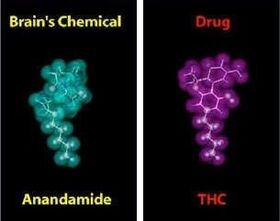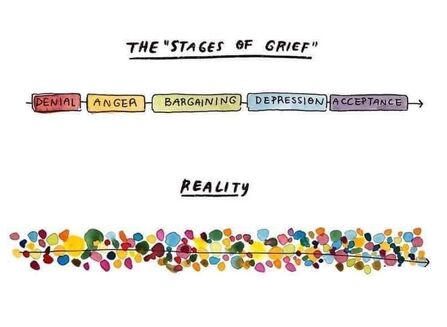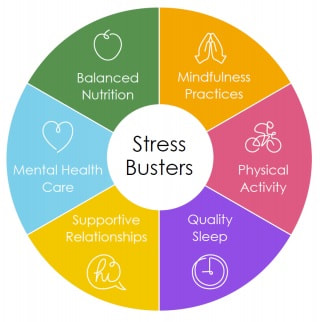 Courtesy of National Institute on Drug Abuse. Courtesy of National Institute on Drug Abuse. Marijuana is a psychoactive substance that's classified as a hallucinogen. Most users of the drug would describe it as a depressant because it induces a state of calm or relaxation. The drug's pretty sneaky though and can have serious implications that are so subtle the user often doesn't connect their use of the drug to its consequences. Initially a person's anxiety may be the motivator for marijuana use but over time the person may notice an increase in anxiety and there's a reason why. Studies show that marijuana in small doses can reduce anxiety but can increase anxiety in larger doses. And the addictive qualities of marijuana turn it into a regular habit where people are smoking larger quantities more frequently, which builds up in the body and boom! - you guessed it - more anxiety. Marijuana is also highly addictive because it triggers the brain's reward system, which also leads to withdrawal. In addition to the reward system, marijuana impacts the endocannabinoid system, which is expressed in all brain regions that are important for processing anxiety, fear, and stress. It's a big player in our nervous system and also regulates biological functions such as eating, learning and memory, reproduction, metabolism, etc. It's what's responsible for giving people the "munchies." The THC molecule is able to attach to the anandamide receptor (see pic). This decreases the endocannabinoid system's tone (think: muscle tone but for the brain) and further adds to marijuana's addictive properties. If the brain doesn't need to create anandamide molecules because a person is replacing it with THC, then the brain loses that tone. This is why a lot of heavy marijuana users aren't hungry unless they're smoking. Because both of these systems are impacted by marijuana you can run into a number of psychological and behavioral issues that may seem like they're not related. Misinformation is a big issue and obstacle in addiction treatment with this drug. Think of every marijuana smoker who's sworn on their life that marijuana is not addictive. The impact on memory, motivation and alertness are all well known but my big concern is the impact it has on a person's mental health. Anxiety isn't the only manifestation of an out of whack endocannabinoid system. People can also feel paranoid and suicidal. Add some denial that marijuana is addictive and/or problematic to the mix and you have someone walking around wondering why they're so depressed and paranoid. Maybe you've had a moment of clarity around your relationship with marijuana or there's someone you care about in your life who's use is out of hand. My suggestion to the former, take a month off and see if your symptoms improve. Another avenue is to examine how marijuana has impacted the following five areas of your life:
Marijuana has very legitimate uses in appropriate doses for medicinal use but when it comes to recreational use, it's a drug like any other drug with addictive qualities and consequences to match. More information can be found here:
Driving under the influence of marjiuana: https://www.nstlaw.com/guides/driving-under-the-influence-of-marijuana/ General information about marijuana: https://nida.nih.gov/publications/research-reports/marijuana/what-marijuana
0 Comments
 "I feel rejected." "It feels like you're disrespecting me." "You abandoned me." Everyone confuses their thoughts and feelings at some point - especially when our brains are hijacked by strong, painful emotions. These strong emotions can trigger a threat response in the brain that has the power to turn our lovers into adversaries and friends into foes. Emotions are pretty basic. A psychologist in the 70's, Paul Eckman, identified 6 basic emotions: Happiness, Anger, Disgust, Fear, Sadness and Surprise. This was a cross cultural exploration of the basic emotions all humans share. We have a much wider range to describe different hues of the primary 6 but you won't find words like abandoned, rejected, disrespected or ghosted. These are actions. Better yet, they're a perception of an action. I'll rewrite the above statements in feelings words: "I feel sad." "I'm angry." "I'm hurt." Take accountability for how you're feeling. They're healthy cues letting you know how to engage with the world. That's where you have the power to assert yourself and create change.  Everyone has needs. If you're alive and a human, you have needs. We all know of the basic needs for shelter, food, water, clothing and sleep but what about interpersonal needs? Needs like safety, affection, connection, play and understanding? In order for us to know what we need, we must know what we're feeling. Feelings indicate whether or not a need is getting met. If I'm scared, I need safety. If I'm joyous, my need for connection is satisfied. The person who says they don't have needs may fear rejection. Totally understandable. But what if it wasn't the need that was being rejected, rather, the strategy used to get that need met? I have a friend who was aloof for most of his life but desperately needed connection. The strategy of being aloof wasn't working to fill his unmet need but he was fearful of intimacy and acting aloof kept him emotionally safe. It wasn't until he learned to set boundaries that he felt safe enough to connect. Changing his strategy from being aloof to assertive allowed him to connect with those around him and get his need met. Substance abuse is another great strategy example. Maybe a person drinks because they feel anxious and need peace, but the strategy of drinking has disastrous long-term effects. There are a number of different strategies to getting peace, like, meditation, exercising or walking. With practice you can change the strategy. It's not easy, but it's possible. The tricky thing about a strategy is the more you do it, the deeper the groove in your brain. And our brains take about 20% of our total energy so it's going to be in default mode most of the time. This default mode is what keeps us stuck in old strategies. Intentionally participating in a different strategy takes more effort. So if you're working on changing your strategies to get your needs met in a different way, give yourself the same kindness you'd bestow upon a friend. Change takes time. I can't remember how I stumbled upon this gem and wish I did so I can give the author credit. The intention of this list is to empower you and act as a reminder that, despite the pressure to see family during the holidays, you always have a choice of HOW and WHEN you do it.
 Communication isn’t difficult. I can scream at someone all day and that’s technically communication. I got my point across. Done. Was it effective? Not really. What causes the most grief is HOW we communicate and understanding the messages we exchange. I like to break down communication into three layers: CONTENT, PATTERNS and FEELINGS/NEEDS. It helps get to the root of the messages in a more authentic way. This is just one framework out of many so take what works and leave the rest. CONTENT: All couples argue about content. “You don’t touch me anymore.” “You never help around the house.” A savvy therapist knows that focusing on content is an uphill battle because the goal post is always changing, e.g. boyfriend begins to help around the house but now he’s a "bad listener." PATTERNS: I often suggest couples communicate about the communication. What I mean is to be curious about and explore communication patterns. Think: behavior. Explore what you notice with open-ended questions and observed behaviors (facts). “I notice that when I complain about work you go on your phone. What’s happening there?” This is getting warmer to the core, bottom layer, which is about… FEELINGS and NEEDS: Now we’re getting somewhere! There’s a wonderful curriculum developed by Marshall Rosenberg called Nonviolent Communication aka Compassionate Communication and there are a number of trainings online anyone can attend. You don’t have to be a shrink to sign up and they’re awesome. In short, feelings arise when we’re either getting a need met or not getting a need met. If I feel fearful I may need safety. If I feel anger I may need respect. It sounds simple but it’s a language that needs mindful practice because we confuse feelings with thoughts and needs with strategies constantly (more on this later in a future blog entry). Once you get to the feelings and needs layer you can make changes from the bottom up. “You feel disgruntled because you need support?” (Notice how there’s no mention of the boyfriend’s lack of help around the house.) MOST times the person will shout “YES!” To which I reply, “Okay, great. Let’s look at ways you can get the support you need.” The pattern usually changes as does the need to focus on the content. It also invites the boyfriend to help resolve the issue since he’s no longer on the defense.  Grief is not a linear process. Makes sense why we would think so - we live in a linear world. Most of us view things as having a beginning, middle and end but not grief. Grief isn’t reserved for losing a loved one either. We can grieve the loss of an ideal, missed milestone, lost childhood, job loss or betrayal. We can also get stuck in a grief stage. Hollywood loves to make movies about it, e.g. the couple in denial who continue to believe they see their deceased child or the bitter widow who turns to alcohol to cope. Even the DSM-V - the statistical manual for mental health disorders - categorizes stuck grief as a major depressive disorder if someone hasn’t reached the acceptance stage by 6 months. People can also get stuck in a grief stage if they’re using substances to cope, which prevents emotional processing. Grief gets a bad rap because it’s an uncomfortable process, especially in Western society where it’s common to grieve behind closed doors. Alone. If you find yourself confused and/or overwhelmed by the different stages and emotions, that’s normal. If you find yourself getting angry when people expect you to be sad, that’s normal. It’s your process. A general rule of thumb is to ask yourself if the grief is interfering with your quality of life and if YOU determine that YOU feel stuck. If so, there are ways to move through the grief. It’s not an easy or painless process, but it’s possible. Also known as covert incest and surrogate spouse, some adults use their children to fulfill unmet emotional needs (not sexual) in the absence of a spouse or in place of an emotionally absent one. It’s incredibly damaging to a child’s development and largely goes unnoticed by the child since it’s normalized in their family. Some examples of emotional incest are:
A parent’s job is to love their child unconditionally, set limits, know their own boundaries, provide attunement and respect that their child is a different person. This helps a child foster their sense of self and set them up for successful relationships. It’s not a parent’s job to think they can use their child for emotional comfort. It’s the parent’s responsibility to seek out other adults and/or their significant other for solace and emotional support. Better yet, if a parent learns how to regulate their own emotions without depending on their child, they’re modeling adult behavior that helps their child navigate life’s challenges. Adult survivors of emotional incest may experience:
If you’ve survived emotional incest and/or are continuing to find yourself in this type of parent/child relationship you can learn to SET BOUNDARIES with the parent. Children are very intuitive and you may have already felt uncomfortable or creeped out by a parent’s behavior for years or maybe you feel incredible guilt as an adult. Listen to your gut. It’s telling you something and it’s okay to start saying NO to the inappropriate behavior. YOUR body and mind, YOUR rules. If you’re interested in learning more about emotional incest to determine if you’re a perpetrator or victim of this type of abuse and you’d like to heal from it, please read, “The Emotional Incest Syndrome,” by Dr. Patricia Love. I heard a quote today that summarized the reason most of us are terrible at apologies. It went something like "acknowledging impact rather than defending intent." Think about that for a minute. How many of us have been in the position of defending intent when we're trying to deliver an apology? It may sound something like, "I'm sorry I yelled at you; I've been so stressed out." The person you just yelled at doesn't care about your stress. At least not immediately after getting yelled at. They care about being yelling at and the impact on them. Imagine if the same person said, "I'm sorry I yelled at you; that must have been really upsetting." That leaves room for a conversation rather than a defense.
This is so common in relationships it's often hard to see. Couples try to be understood without realizing how their behavior has impacted their partner. It can be very disarming when someone recognizes their part and takes accountability because it's vulnerable. Give it a try. I bet it takes the steam out of any argument.  Finding the right therapeutic fit can be stressful. I’ve heard stories of therapists not calling clients back. Sometimes a client didn’t know what type of therapy they needed and found out months later that it wasn't a fit. My intention is to give you some guidance on how to find a therapist that fits your needs. You’re the consumer. Therapists offer a service. You have every right to ask the therapist questions about their training, capabilities and areas of expertise. Questions you might ask:
As far as specific modalities, there are psychodynamic therapists, which may help you build insight. Some psychodynamic therapists may suggest meeting twice, sometimes thrice a week. It can be costly and exactly what some are looking for. There are CBT (Cognitive Behavioral Therapy) practitioners. You focus on your thoughts, behaviors and emotions, and the effect they have on one another. You can expect to answer questions in percentages, track your behaviors and get homework. It’s more solution focused, less insight based (typically) and exactly what some people are looking for. There are Internal Family Systems therapists. This helps explore the different “maladaptive coping skills” as parts that get developed to protect your core self. It’s effective in addressing childhood trauma, suicidality, substance abuse, etc. and is exactly what some people are looking for. These are just a few examples of different types of therapy. I think it's safe to say that most therapists fall under the “eclectic” category - a practitioner that uses a number of interventions and modalities - because we know that one style doesn't fit everyone's needs. I also recommend looking for red flags when interviewing therapists: does the therapist get defensive in response to your questions, refuse to offer a free consult call and/or neglect to call you back? If these red flags come up, move on. Ideally, you want a therapist who’s supportive and open with good boundaries, not someone who's neglectful, overly rigid or assumes you’ll be a good match without careful consideration. In short, know what you need to the best of your ability, inform yourself about the different therapeutic approaches, ask questions and interview at least 3 therapists. With a little work and patience you'll find your fit. Good luck in your search!  From California's Office of the Surgeon General From California's Office of the Surgeon General There are a number of resources out there that are helpful with managing pandemic anxiety and keeping connected to group resources. The picture on the left is from the State of California's Surgeon General's Office. They wrote a wonderful article that offers practical tips on how to incorporate and maintain self-care: https://files.covid19.ca.gov/pdf/wp/california-surgeon-general_stress-busting-playbook_draft-v2clean_ada-04072020.pdf Psychology Today hosts a number of articles that help with pandemic anxiety. This one in particular addresses anxiety contagion: https://www.psychologytoday.com/us/blog/pain-explained/202003/anxiety-contagion-tips-relief A dear client informed me of this one and its sole purpose is to help with virus anxiety: https://www.virusanxiety.com/ Daybreaker is a worldwide wellness movement that offers yoga and dance in a sober environment. They have been offering virtual events that are also family and kid friendly: https://www.daybreaker.com/city/live/ Day drinking, overeating and maybe even drugs have become more of a thing with more people working from home or not working at all:
Virtual meditation platforms are also helpful, like, InsightTimer, Calm and online sessions via www.shambhalaonline.org. It's unfortunate that domestic violence and suicide rates increase in times of stress. Below are resources if you find yourself experiencing this type of crisis:
The most helpful thing to remember is that you always have choices. No matter where you're at or with whom. |